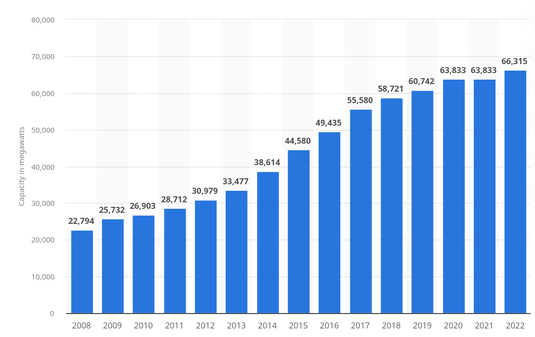Growth in german wind capacity is slowing. Soo… then the plan is to keep on with lignite and gas? Am I missing something?
Installed Wind Capacty - Germany

Growth in german wind capacity is slowing. Soo… then the plan is to keep on with lignite and gas? Am I missing something?
Installed Wind Capacty - Germany

Nice, ignoring 99% of my comment to attack a strawman. The sun covers half the globe at any one time. I’m not suggesting that somewhere in midnight takes solar power from somewhere in midday. For example power can be moved across the US grid, which covers three timezones, which gives solar 3 hours more viability.
Not a strawman when you respond to “sometimes it’s night and solar doesn’t work” with “it’s daytime somewhere”. The natural assumption is that your intention was that day side power could be used on the night side.
Do you have anything to back up your idea that the US grid can or does actually supply power across the entire nation?
Your assumption is mostly correct - “day side power can be used on the night side”. Say that you live in a city where the sun sets at 7pm. The largest synchronous power grid in the world is in Continental Europe - from east to west, it’s approximately 5600 km, and connects Portugal (UTC 0) all the way to Turkey (UTC +3), covering three time zones. That means when the sun sets in Portugal, solar panels in Turkey are still generating power at 75% efficiency.
As you can understand, this is an entirely different claim from “we would get power from the other side of the world”. It’s a strawman because that’s the weakest possible version of the argument I made.
As for the US power grid, no, you’re right, I was totally wrong about that. I had thought that the east and west power grids were connected, but it seems that they still haven’t sorted that out yet. Thanks for correcting me. It looks like they have a project in the planning stage to make it happen (Tres Amigas SuperStation) but it probably won’t be for a while. It’s absolutely achievable, though, and pretty easily.
It would also be achievable to get a single planetary power grid, theoretically, but I think it’s practically impossible to achieve that at the moment. It would need a level of global cooperation far beyond what we have ever accomplished. Definitely a future goal for our species!
Transmission losses prevent most of what you are suggesting. Across a continent, even with high voltage low loss power lines, you lose 35% to resistance. This doesn’t count the added loss from stepping down the voltage at various substations and transformers along the way. You can expect another 8-15% more reduction from that.
You’re suggesting that the amount of excess power from one side of the country could be enough to power the other side (while still meeting the demands locally) with 40-55% losses. Come on.
Absolute bullshit. HVDC cable power loss is between 0.3% and 1% per 100km. And when it comes to UHVDC, a typical loss for 800 kV lines is 2.6% over 800 km. Transformers and substations cause a power loss of around 0.5% to 2%.
https://www.nationalgrid.com/sites/default/files/documents/13784-High Voltage Direct Current Electricity – technical information.pdf
https://ieeexplore.ieee.org/document/6761670
By the way, even with your completely wrong, off by a factor of ten numbers, renewables with that transmission loss would still still cheaper than nuclear, safer than nuclear, and quicker to provision than nuclear. Sucks to suck.
It bothers me that you want to educate people but you are being so combative and smug. This isn’t the way to change people’s minds. All you are doing is making people feel personally attacked and driving them further away from having an open mind.
This is the first I’ve heard of HVDC, my experience is with typical AC transmission that makes up most of the current grid. Not a lot of experience, but college physics level.
US high voltage transmission is usually AC in one of the following voltages: 345 kV, 500 kV, or 765 kV. I used the 765 kV worst case losses of 1.1% per 100 miles (according to American Electric Power Transmission Facts Q12) which is over generous since most transmission would likely not be using only the high efficiency lines.
Also, transmission range is affected by load and high load reduces line capability.
We’re talking about moving a huge amount of power across 3000 miles. In my experience transmitting power across a nation as large as the US is unheard of.
You also seemed to have missed my point about how much excess power would be required to power the opposite side of the country (in the dark) while basically at dusk. Let’s say 30% of the east coast’s power comes from solar. That would mean that the West Coast would need to provide that 30% excess on top of their current energy demands during a relatively high demand time period. It would also be a bit unfair for the West Coast to be the ones responsible for over-provisioning to accommodate the east coast.
Is HVDC even installed and able to transmit across the US now?